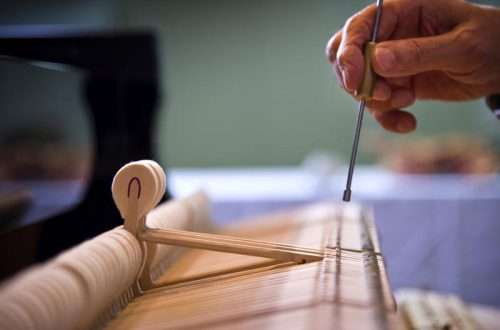
How to tune a Dulcimer
Contents
If you have not had to tune a dulcimer before, you may think that only professionals can do it. In fact, the setting of a dulcimer is available to anyone. Usually the dulcimer is tuned to the Ionian mode, but there are other tuning options.
Before you start tuning: Get to know the dulcimer
Determine the number of strings. Usually 3 to 12, most dulcimers have three strings, or four, or five. The process for setting them up is similar, with a few minor differences.
- On a three-string dulcimer, one string is melody, another is middle, and a third is bass.
- On a four-stringed dulcimer, the melodic string is doubled.
- On the five-string dulcimer, in addition to the melodic string, the bass string is doubled.
- The double strings are tuned the same way.
- If there are more than five strings, tuning should be done by a professional.

Examine the strings. Before you start tuning, find out which pegs are responsible for which strings.
- The pegs on the left are usually responsible for the middle strings. The lower right pegs are responsible for the bass strings, and the upper right for the melody.
- When in doubt, gently twirl the peg and try to figure out which string is being tightened or loosened, visually or audibly. If you can’t find out, contact an expert.
- The strings are counted in order, starting with the melodic string. Thus, the bass string on a three-string dulcimer is called the “third” string, even if you start tuning there.
First method: Ionian mode (DAA)
Tune the bass string to small D (D3). Stroke an open string and listen to the resulting sound. You can tune this string to guitar, piano or tuning fork. [2]
- D of a small octave on a guitar corresponds to an open fourth string.
- You can try to tune the bass string to your voice by singing the note D.
- Tuning to the Ionian scale is widespread and is also called “natural major”. Most American folk songs can be thought of as songs in “natural major”.
Tune the middle string. Pinch the bass string on the left at the fourth fret. The open middle string should sound the same, adjust the pitch with the appropriate peg. [3]
- The first two strings, in most cases, are tuned in the same way, regardless of the selected tuning.
Tune the melody string to the same note as the middle string. Stroke the open string, and turn the peg to produce the same sound as on the open middle string.
- This sound corresponds to the note A, and is also extracted from the bass string, clamped to the left at the fourth fret.
- The Ionian fret goes from the third to the tenth fret. You can also play additional notes by pressing the strings higher or lower.
Second method: Mixolydian mode (DAD)
Tune the bass string to small D (D3). Stroke an open string and listen to the resulting sound. You can tune this string to guitar, piano or tuning fork.
- If you have a guitar, you can tune the bass string of the dulcimer to the open fourth string of the guitar.
- If you don’t have a tuning fork or other instrument to tune the dulcimer to, you can try tuning the bass string to your voice by singing D.
- The Mixolydian mode differs from the natural major by a lowered seventh degree, which is called the Mixolydian seventh. This mode is used in Irish and Neo-Celtic music.
- As you can see, tuning the bass and middle strings is no different from the previous method, so once you master these two steps, you can tune a three-string dulcimer to just about any fret.
- The melodic string should sound an octave higher than the bass string.
- This tuning loads the melodic string more.
- The Mixolydian mode starts on the open first string and continues up to the seventh fret. The notes below are not provided on the dulcimer, but there are notes above.
Third Method: Dorian Mode (DAG)
- The open fourth string of the guitar gives the desired sound.
- You can try to tune the bass string to your voice by singing the note D. This is an imprecise method, but it can give an acceptable result.
- The Dorian mode is considered more minor than the Mixolydian mode, but less than the Aeolian mode. This mode is used in many famous folk songs and ballads, including Scarborough Fair and Greensleeves .
- Master the tuning of these two strings, this is crucial.
- To lower the pitch of the melodic string, you need to loosen the tension of the peg.
- The Dorian mode starts at the fourth fret and continues through the eleventh. The dulcimer also has a few extra notes above and below.
Fourth Method: Aeolian Mode (DAC)
Tune the bass string to small D (D3). Stroke an open string and listen to the resulting sound. You can tune this string to guitar, piano or tuning fork. Continue tuning until the bass string sounds the same as on that instrument.
- If you have a guitar, you can tune the bass string of the dulcimer to the open fourth string of the guitar.
- If you don’t have a tuning fork or other instrument to tune the dulcimer to, you can try tuning the bass string to your voice by singing D.
- The Aeolian mode is also called the “natural minor”. It has weeping and howling intonations and is well suited to Scottish and Irish folk songs.
- Absolutely the same as in the previous setup methods.
- You may need to loosen the melody string when tuning.
- The Aeolian mode starts at the first fret and continues through the eighth. The dulcimer has one extra note below, and many above.
What will you need
- Dulcimer
- Wind tuning fork, piano or guitar





